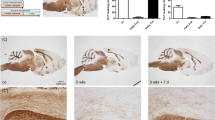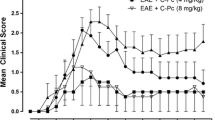Abstract
While proteolytic enzymes are involved in the pathogenesis of multiple sclerosis (MS), the involvement of cathepsins has not been characterized in detail. To better understand the role of cathepsins, cDNA microarray analysis was used to study the brains of proteolipid protein transgenic (plp tg /−) mice, an animal model that closely mimics the failure of remyelination in MS. Analysis revealed upregulated expression of cathepsins L, H and B and their inhibitor, cystatin C. By in situ hybridization, the induction of cathepsins was primarily limited to microglia/macrophages of the white matter, with continuous expression from 2 to 8 months of age. Elevated protein level of cathepsins was confirmed at 4 months of age. In contrast, elevated expression of cystatin C was found in astrocytes. The ratio of microglia/macrophages to astrocytes increased throughout the course of demyelination, suggesting that the ratio of secreted cathepsins to cystatin C increased during that period. We propose that in MS, remyelination may be impaired by increasing activity of cathepsins inadequately controlled by cystatin C.







Similar content being viewed by others
References
Chang A, Nishiyama A, Peterson J et al (2000) NG2-positive oligodendrocyte progenitor cells in adult human brain and multiple sclerosis lesions. J Neurosci 20:6404–6412
Scolding N, Franklin R, Stevens S et al (1998) Oligodendrocyte progenitors are present in the normal adult human CNS and in the lesions of multiple sclerosis. Brain 121:2221–2228
Kagawa T, Ikenaka K, Inoue Y et al (1994) Glial cell degeneration and hypomyelination caused by overexpression of myelin proteolipid protein gene. Neuron 13:427–442
Ma J, Matsumoto M, Tanaka K et al (2006) An animal model for late onset chronic demyelinaion disease caused by failed terminal differentiation of oligodendrocyte. Neuron Glia Biol 2:81–91
Guyton M, Sribnick E, Wingrave J et al (2004) Axon damage and neuronal death in multiple sclerosis and experimental autoimmune encephalomyelitis: the role of calpain. In: Multiple Sclerosis as a neuronal disease. Elsevier, London, pp 295
Bever CT Jr, Garver DW (1995) Increased cathepsin B activity in multiple sclerosis brain. J Neurol Sci 131:71–73
Nagai A, Murakawa Y, Terashima M et al (2000) Cystatin C and cathepsin B in CSF from patients with inflammatory neurologic diseases. Neurology 55:1828–1832
Irani DN, Anderson C, Gundry R et al (2006) Cleavage of cystatin C in the cerebrospinal fluid of patients with multiple sclerosis. Ann Neurol 59:237–247
Gan L, Ye S, Chu A, Anton K et al (2004) Identification of cathepsin B as a mediator of neuronal death induced by Abeta-activated microglial cells using a functional genomics approach. J Biol Chem 279:5565–5572
Quackenbush J (2003) Microarrays—guilt by association. Science 302:240–241
Brzin J, Popovic T, Turk V et al (1984) Human cystatin, a new protein inhibitor of cysteine proteinases. Biochem Biophys Res Commun 118:103–109
Barrett AJ, Davies ME, Grubb A et al (1984) The place of human gamma-trace (cystatin C) amongst the cysteine proteinase inhibitors. Biochem Biophys Res Commun 120:631–636
Grubb AO (2000) Cystatin C—properties and use as diagnostic marker. Adv Clin Chem 35:63–99
Banati RB, Rothe G, Valet G et al (1993) Detection of lysosomal cysteine proteinases in microglia: flow cytometric measurement and histochemical localization of cathepsin B and L. Glia 7:183–191
Lignelid H, Collins VP, Jacobsson B (1997) Cystatin C and transthyretin expression in normal and neoplastic tissues of the human brain and pituitary. Acta Neuropathol 93:494–500
Norenberg MD, Martinez-Hernandez A (1979) Fine structural localization of glutamine synthetase in astrocytes of rat brain. Brain Res 161:303–310
Bever CT Jr, Panitch HS, Johnson KP (1994) Increased cathepsin B activity in peripheral blood mononuclear cells of multiple sclerosis patients. Neurology 44:745–748
Ponomarev ED, Shriver LP, Maresz K, Dittel BN (2005) Microglial cell activation and proliferation precedes the onset of CNS autoimmunity. J Neurosci Res 81:374–389
Gan L, Ye S, Chu A, Anton K et al (2004) Identification of cathepsin B as a mediator of neuronal death induced by Aβ-activated microglial cells using a functional genomics approach. J Biol Chem 279: 5565–5572
Acknowledgments
We thank Dr. Katsuhiko Ono and Seiji Hitoshi for valuable discussions, and Ms. Rie Taguchi for technical assistance. This work has been supported by the Grant-in Aid (Grant no.15082209) for Scientific Research on Priority Areas on “Elucidation of glia-neuron network mediated information processing systems” from MEXT to KI.
Author information
Authors and Affiliations
Corresponding author
Additional information
Special issue dedicated to Anthony Campagnoni.
Rights and permissions
About this article
Cite this article
Ma, J., Tanaka, K.F., Yamada, G. et al. Induced Expression of Cathepsins and Cystatin C in a Murine Model of Demyelination. Neurochem Res 32, 311–320 (2007). https://doi.org/10.1007/s11064-006-9183-y
Received:
Accepted:
Published:
Issue Date:
DOI: https://doi.org/10.1007/s11064-006-9183-y




